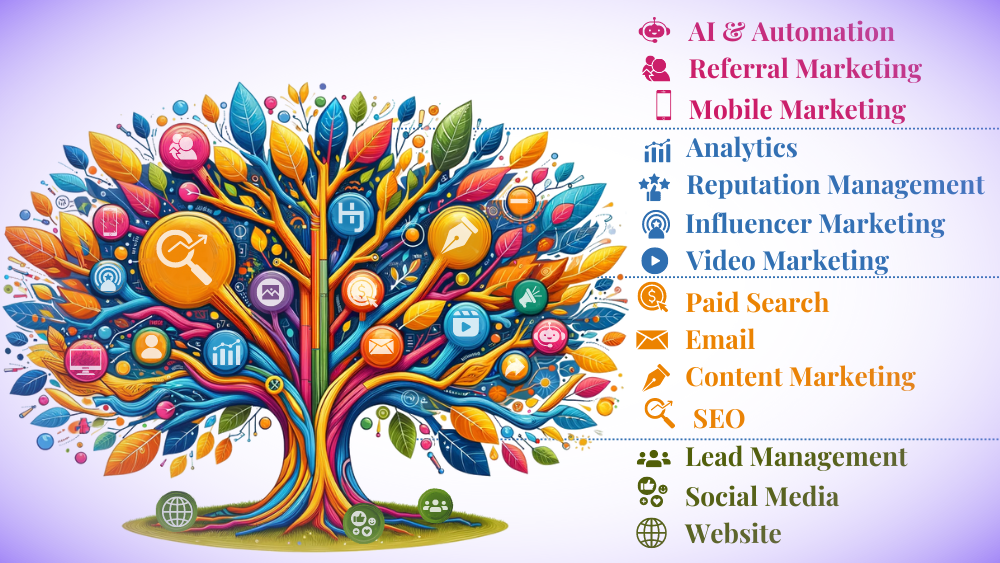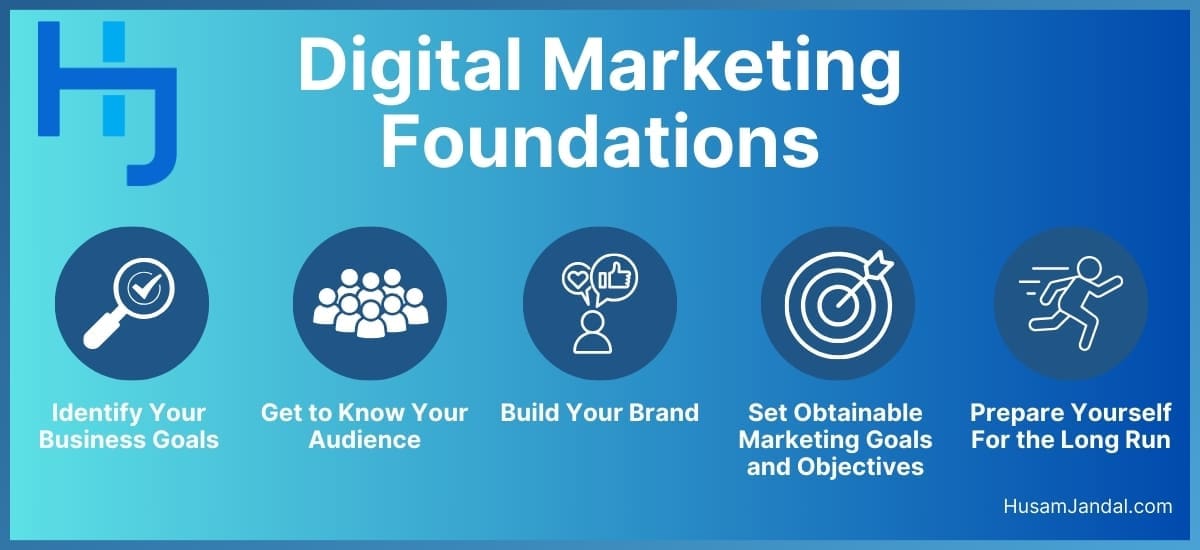 One of the most common questions I hear is, “Where do I get started with digital marketing?” It can seem a bit overwhelming with so many channels and potential strategies. I like to simplify the process by using the digital marketing tree analogy. Give me a few minutes, and I’ll walk you through how it works.
One of the most common questions I hear is, “Where do I get started with digital marketing?” It can seem a bit overwhelming with so many channels and potential strategies. I like to simplify the process by using the digital marketing tree analogy. Give me a few minutes, and I’ll walk you through how it works.
Climbing the Digital Marketing Tree
Using the digital marketing tree methodology, you start at the bottom of the tree and gather the easiest and highest-yield “fruit” first, then work your way up the tree to more challenging and resource-intensive strategies. There are four levels of fruit: ground, low-hanging, mid-range, and distant.
This approach:
- Ensures you see strong results from your efforts early on. That way, you have a return on marketing investment (ROMI) and will likely stay motivated to continue building your brand.
- Allows you to ramp up slowly. You build your digital marketing team and allocate additional resources as you move through each level.
- Enables you to snowball your results and ROMI. Because each level improves your overall results and generates ROMI, you can use the profit from earlier initiatives to fund later ones, and you’ll see even greater returns as you continue up the tree.
Lay the Foundation First
It’s imperative to lay the foundation for strong digital marketing before working on any initiatives from the digital marketing tree. This includes:
- Identifying your business goals. You need to have company-wide goals before leveraging digital marketing strategies to help you get there.
- Getting to know your audience. The average person sees up to 10,000 ads each day, according to Zippia. They receive more than 120 emails daily, too, per Campaign Monitor. The best way to cut through all that noise is to tailor everything you do to specific buyer personas.
- Building your brand. Strong and consistent branding is more important than SEO. Know what your brand stands for, how it speaks, who it’s for, and what it delivers. You’ll be reinforcing these core concepts in all your digital marketing efforts.
- Setting attainable marketing goals and objectives. You may need to finetune these as you go. The important thing is that you have some marketing metrics in mind and are working toward something specific.
- Preparing yourself for the long run. Digital marketing is constantly evolving, and you’ll deploy your strategies in stages. Be committed to lifelong learning and the process before you begin.

Work Through the Levels in Order
The digital marketing tree involves working through ground, low-hanging, mid-range, and distant fruit in that order. However, if you have already begun some initiatives out of order, that’s okay. It’s generally best to pause those efforts to avoid consuming resources without getting ROI and return to the start. When you reach those activities as you climb the tree later, you can resume activities and shore up those strategies.
Step 1: Collect the Ground Fruit
The digital marketing tree’s first step is gathering the ground fruit. These initiatives are the easiest to implement and are an effective way to kickstart your digital marketing. You also won’t need a full digital marketing team for these strategies, though they allow you to begin building one and deliver fast results. Your business website and social media marketing fit into this category.
Website
Your business website is the first piece of ground fruit to collect because the goal of virtually every other strategy is to get people to visit your website.
Tips for Starting Your Website
While this is not a definitive list, a few things to remember as you plan your website are highlighted below.
- Hire a pro. Because this task is central to all your digital marketing efforts, it should be handled by a professional. Most businesses will do better by outsourcing website development, though it’s crucial to select someone you can build a long-term relationship with so they can handle maintenance and updates.
- Choose your domain name wisely. Ensure you choose a web address that makes sense to users, is memorable, and will grow with you.
- Build with users in mind. Google and other search engines send people to sites they think will provide the best user experience. The criteria they use changes, but the goal does not.
- Consider the future. Will the pricing tiers make it cost-prohibitive as your business grows? Can you extract your data and move to a new platform if needed? Does it offer all the features you’ll need as you grow? These are just a few things to consider before you commit.
Social Media
Brands often start with social media marketing before they set up a website because they’re already familiar with it, and it seems less intimidating. However, social media doesn’t create substantial results without a cohesive strategy and website. Conversely, as ground fruit and deployed with a strong strategy, social media is a low-cost, high-reward tactic.
Ways to Make the Most of Social Media
Apply the following tips to maximize your social media kickoff and beyond.

- Set realistic goals. Focus more on brand awareness and engagement than sales and leads.
- Be where your personas are. Focus your efforts on just one or two social networks to start. You don’t need to be everywhere – just the platforms where your personas are most active.
- Develop a social media content plan. Plan your content ahead of time and use a social media scheduling tool to boost efficiency.
- Have resources in place. Because customers will likely start leveraging your social media profiles as customer service channels, you will need a dedicated social media manager to monitor them. In addition to a social media scheduling tool, that person may also need access to content creation tools.
- Give it time. It takes months of consistent posting and finetuning before brands start to see results.
Lead Management
Nine in ten marketers rate lead generation as their most important goal, according to Ruler Analytics. However, what you do with those leads is just as crucial. By leveraging customer relationship management (CRM) software and developing a strong lead management process, your business can easily identify which leads are most likely to convert, streamline the sales process, distribute work for greater efficiency, close more deals, and boost ROI.
Stages of Lead Management
- Lead generation is what occurs when your lead enters your CRM. Be sure you can identify their sources and which channels produce the best leads.
- Lead qualification and segmentation involves organizing the leads that come into your CRM. Ensure you can tell the difference between a sales classified lead (lead), sales-qualified lead (prospect), and sales solidified lead (opportunity).
- Lead nurturing is the process of sending leads tailored or targeted content to help them become prospects. Much of this can be automated. Just be sure to monitor the success of your campaigns and make improvements as you go.
- Lead scoring and distribution refers to identifying which leads your sales repos should prioritize and making sure each lead is assigned to the right sales rep. This can also be automated, though processes must be designed around the way your team works best to ensure all leads receive the attention they deserve.
- Success measurement involves identifying how your team measures success as well as how you track and monitor KPIs. Metrics such as cost per lead, lead conversion rate, speed-to-lead, and more can be helpful here.
Step 2: Gather Low-Hanging Fruit
After you’ve harvested the ground fruit, you can collect the low-hanging fruit. These initiatives often build on what you’ve already accomplished. They aren’t necessarily difficult to implement but require additional skill sets and strategy. SEO and content marketing fit into this category.
SEO
Having a high organic ranking in industry terms is a huge advantage over your competitors. Taking SEO into consideration early is a smart choice as it takes time to build enough content, optimized web pages, and referral links to have strong search rankings.
Factors That Impact Your SEO
Search engines want to give users the best possible experience, so they consider how likely you are to meet their needs overall before they send visitors to your website. A few factors they evaluate when determining if your site appears in someone’s search and where your site lands in the rankings are covered below.
- Relevance to the search. If your page contains keywords used by the searcher and appears to match their intent, you’ll likely rank higher in search engine results pages (SERPs).
- On-page optimization. Factors such as the uniqueness and quality of content, presence of meta tags, and subheadings influence rank.
- Off-page optimization. Your site appears more authoritative and popular if other high-quality sites link to it.
- Site speed. The likelihood of a bounce (someone landing on your page and leaving without taking any action) jumps by 32 percent as page load time goes from one to three seconds, according to Google. Because of this, sites that load faster typically rank higher.
- Mobile-friendliness. Around two-thirds of organic search engine visits now originate from mobile devices, Statista reports. Google prioritizes the mobile version of your site for crawling and indexing for this reason. You must deliver an excellent user experience on all devices to rank well.
Content Marketing
Content marketing is more time-consuming than creating simple social media content because it’s longer, involves preparation, and requires a bit more research. However, its impact and value are significant. Effective content marketing helps establish your organization as an industry leader and gets people in the habit of turning to it for information.
Types of Content Marketing to Consider
Each of your personas may prefer a different content medium. You may also notice shifts in preferred mediums throughout the customer journey, too. A few types of content to experiment with are covered below.
- Blogs. Longform blog posts on your website are a cornerstone of content marketing.
- Case studies and whitepapers. Case studies that cover your customer success stories or whitepapers that showcase your expertise can help encourage people nearing purchase readiness to select your business.
- Checklists. Checklists to help your audience complete specific activities or prepare for things can be invaluable tools for your audience at various stages of the customer journey.
- Guides and e-books. Detailed guides that are longer than a traditional blog can be especially useful to your audience.
- Infographics. Infographics boost engagement and can help your content get shared more often.
- Interviews. Consider interviewing your current clients or subject matter experts.
- Kits, tools, and calculators. Interactive content can take more time to develop but tends to be more engaging.
- Podcasts. Some brands do exceptionally well with their own branded podcasts. You can experiment with being a guest on other podcasts as well.
- Videos. There are many ways to leverage video marketing, from short animated explainers to video case studies.
Email Marketing
Businesses receive an average of $36 back for each $1 spent on email marketing, Litmus reports. You can kick off with little more than a website to send people to, CRM software for storing customer data, an email marketing program for creating and sending campaigns, and the help of an email marketing specialist. Plus, it has a very high return, so it fits nicely into low-hanging fruit strategies.
Types of Email Marketing Campaigns to Leverage
There are lots of potential email marketing campaigns your business can run. A few that you might want to consider are covered below.
- Welcome emails. Greet new customers or subscribers and encourage them to engage with your brand in new ways.
- Surveys. Engage your audience and get their feedback on your products or services, the customer experience, or ways your brand can support their needs.
- Reengagement campaigns. You must remove inactive contacts from your email lists to keep deliverability high. Reengagement campaigns offer an opportunity to connect with people on your list before they are removed.
- Announcements. Share details about your new website, product releases, new features, and more.
- Case studies and whitepapers. These can reinforce your reputation as a subject matter expert and build trust.
- Promotional messages. Unless you run an e-commerce business, only a very small fraction of your messages should be promotional in nature. Abandoned cart messages and sales fit into this bracket.
Paid Search
Paid search is a specific type of pay-per-click (PPC) ad that allows you to display your information alongside organic search results in Google, Bing, Yahoo, and other search engines. PPC delivers an average of $2 for each $1 spent, Small Biz Genius reports. It also starts working instantly, which gives it an advantage over organic strategies. However, it’s easy to make mistakes with PPC, and campaigns require continuous optimization to produce the best possible results. PPC management also draws on multiple skill sets, such as strategy, copywriting, and landing page design. It’s low-hanging fruit for these reasons, and most small and mid-sized businesses outsource PPC as a result.
Things to Consider Before You Begin Paid Search
Before you deploy your paid search campaigns, it’s essential to consider the following points.
- Your customer lifetime value (CLV) can help guide your spend. Many businesses underbid on paid search because they don’t realize how much a customer is really worth. Calculate your CLV to better understand how much you can reasonably spend to acquire a customer.
- Think beyond Google. Although Google Search dominates the market, you may also want to run campaigns on other platforms, such as Microsoft Advertising, which typically yields similar results for less.
- You will need a full funnel. PPC ads don’t work alone. You’ll need dedicated landing pages, lead generation forms, a CRM, and a way to assign leads to a sales rep for prompt follow-up.
- Optimization is ongoing. Your PPC specialist will need to add negative keywords to your campaigns and remove low-performing keywords and ad groups from campaigns to ensure your budget goes to high-performance areas.
Step 3: Reach for Mid-Range Fruit
You can go for the mid-range fruit when you’re ready to reach and commit to long-term initiatives. These strategies deliver strong results but require comparatively larger resource investments to develop, plan, and implement than the aforementioned low-hanging digital fruit— video marketing and influencer marketing fit into this category.
Video Marketing
You can weave video marketing into all your existing strategies, including website, social media, and email, to boost engagement. However, you will need additional skills and tools before you begin.
Video Marketing Tips
- Start with a goal. Know whether you want to measure views, likes, or shares and decide what success looks like for your brand.
- Tailor content to your audience. Leverage personas and craft videos to suit each stage of the journey.
- Use High-Quality Tools. Low-quality equipment can make your videos look unprofessional. If you can’t invest in good tools, consider outsourcing your video marketing.
- Be consistent. Your videos should be instantly recognizable as yours.
- Be Brief. Maximize engagement by keeping videos under two minutes and targeting around 60 seconds.
- Include a Call-to-Action (CTA). Leave viewers with their next step.
- Optimize for SEO. Include keywords in the description, title, and file name to help it appear in more searches.
Influencer Marketing
Engaging in influencer marketing allows you to expand your reach with a dedicated audience. Because your influencer behaves like an extension of your brand, it’s important to choose the right person and make sure you’re on the same page before starting.

Tips for Choosing the Right Influencer
- Consider reach. It may be more beneficial to work with an influencer who has a smaller audience that they’re well in tune with when you’re just starting out.
- Examine relevance. Your influencer should be in your niche and viewed as an authority.
- Look into resonance. The more engagement your influencer receives, the more likely you are to have a successful campaign.
Reputation Management
The average person mentions brands 56 times per week in normal conversation, per Deloitte research. In the digital age, many of these discussions occur online. With reputation management strategies, your brand helps shape those conversations.
Tips for Developing a Reputation Management Strategy
- Develop guidelines before you need them. Don’t wait until you have a problem that needs to be addressed.
- Produce brand-related content. This keeps you in control of your brand’s story and helps ensure positive sentiments dominate search engine results.
- Listen to customers. Proactively request feedback and monitor discussions to improve your offerings and service.
Analytics
Analytics is an element that can be included in every other digital marketing strategy. From simple analytic points such as social media engagement to tracking paid search conversions, analytics lets you determine whether or not you are achieving your goals with the digital marketing efforts you’re dedicating to the different marketing channels and increasing your ROI.
Step 4: Expand into Distant Fruit
Toward the top of the tree, you have the digital fruit that takes the most time and planning to leverage. Mobile initiatives and referral marketing fit within this category.
Mobile
Components for mobile devices are also technical in nature and more difficult to implement. Consider leveraging apps, QR codes, and local search to promote your brand among mobile users once you reach this stage.
Referral Marketing
Encourage happy customers and associates to spread the word about your business. A strong referral program can help you raise brand awareness, increase conversions, decrease churn, boost CLV, and increase profit. Develop a formal process that allows you to incentivize referrals and thank referral sources.
Artificial Intelligence (AI)
Although AI is an incredibly powerful tool, it’s best to hold off on incorporating AI in your digital marketing until you already have strong processes and quality assurance guidelines in place. It should be used as a tool to help your team work more efficiently rather than as a replacement for human oversight.
Automation
While some marketing automation is AI-powered, most marketing software is simple, and leverages trigger or rule-based automation to handle specific processes, such as sending emails, segmenting audiences, and lead scoring. To get started with this, talk to your team about which repetitive tasks they complete the most, then look into your existing software to see what automation options are available.
Step 5: Generate More Fruitful Results
Moving beyond traditional digital marketing strategies and channels, there are a few more things you can do to help ensure your harvest is as bountiful as possible.
Revenue Optimization
Simply put, revenue optimization is about improving your business income through various means, such as bringing in new customers (acquisition), getting existing customers to stay longer and order more (retention), upselling or cross-selling to existing customers (expansion), and/or identifying the right price and price model to generate the most revenue (pricing). Identify one or two areas at a time to work on and deploy strategies methodically so it’s easy to see what produces the best results and minimize risk.
CLV-Oriented Budget
When you reverse-engineer your digital marketing budget, your thinking shifts from trying to maximize what you’re given to identifying what it will take to get you where you want to go.
To do this, you’ll use your actual data, including customer lifetime value (CLV) and costs, along with your goals, to determine your budget.
Get Help Climbing the Digital Marketing Tree
The digital marketing tree makes it easy to visualize the basic elements of digital marketing at each stage of the process. I’ve also provided some insights as to what occurs during the implementation of each strategy, so it’s easier to understand why each initiative is placed where it is on the tree. However, this is only an introduction. Each channel requires its own strategy, and initiatives must align with each other to yield the best possible results. If you’re unsure which initiative your business should address next, have questions about implementation, or want greater insights into your digital marketing, I’m happy to help. Contact me for a complimentary consultation.





































































